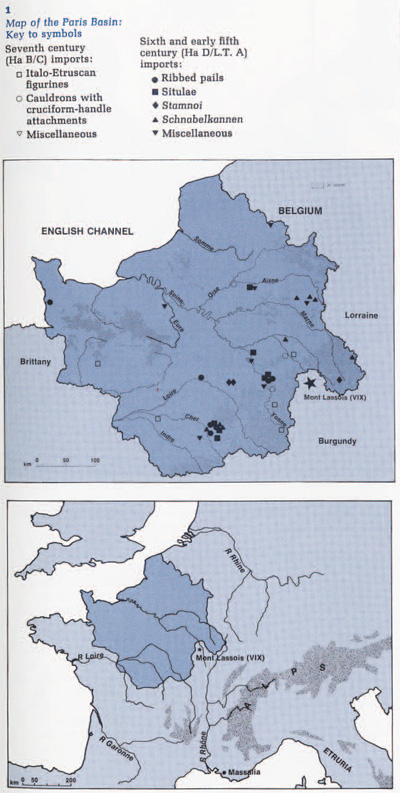 Introduction
Introduction
The study of Early Iron Age luxury bronze imports in Trans-Alpine Europe has tended to spotlight the better-documented regions of southwestern Germany and eastern France (the Westhallstattkreis of German archaeologists), with comparatively little attention being given to the more peripheral areas. The Paris Basin is a case in point.
The Basin, a large geological depression with the French capital at its center, is encased by the Hercynian massifs of the Massif Armoricain (i.e. Brittany) to the west, the Massif Central to the south, the Vosges to the east and the Ardenne to the northeast. The drainage system, a determining factor in the patterns of communication and settlement, is dominated by the Seine in the north and the Loire in the south, and their tributaries, flowing in a northwesterly direction toward the English Channel and the Bay of Biscay respectively (Fig. 1).
This short paper considers a relatively small number of bronze artifacts imported into the Paris Basin, from the Mediterranean and from eastern Europe, during the Hallstatt C and D phases (Hallstatt A and B being Late Bronze Age), and La Tène A—these names derive from sites in Austria and Switzerland, respectively. In calendrical terms, we are dealing with the period from about 700 to 450 B.C.
The bronze imports under consideration may be loosely termed ‘luxury’ products because of their general rarity in the archaeological record, and because, when found in context, they normally occur in richly-furnished graves. These goods, often technically sophisticated, were seldom reproduced locally and are therefore easily identifiable as imported. The majority are vessels and related objects—notably tripod supports and griffon-heads—which suggests a limited function restricted to a small but influential clientele. In this context, it is attractive to view these artifacts as ‘political’ (Wells 1977: 192-3) or ‘prestige’ (Frankenstein and Rowlands 1978) gifts exchanged by southern and eastern European merchants and political figures in return for certain economic and political favors.
An attempt will be made here to explain the presence of these bronzes so far removed from their centers of production.
Material Evidence
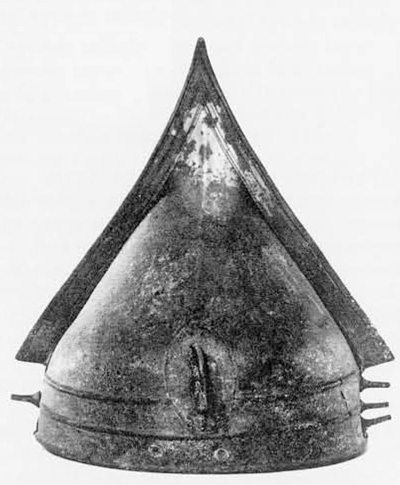
Interaction, represented by imported bronze artifacts, between southern and eastern Europe on the one hand and the Paris Basin on the other, can be traced back to the final stages of the Late Bronze Age. From the Mediterranean world, it is represented by such diverse items as a number of Italic fibulae types (Duval et al. 1974), distributed widely if sparsely across the Basin, and the crested helmets with pointed caps (Fig. 2) of Villanovan inspiration, from the hoard at Bernières-d’Ailly in Lower Normandy (Hencken 1971: 9, 66-72). Eastern European contacts are attested by several hammered bronze bowls from hoards in the Champagne, at Saint-Martin-sur-le-Pre (Lallemant 1924-26), and in the middle Loire region, at Fresnes (Despriée 1978).
By the second half of the seventh century, bronze ‘warrior’ figurines (Fig. 3), thought to be the work of Tuscan craftsmen in Volterra and Arezzo (Boucher 1970: 194), make their appearance in the Paris Basin. At Thorigné-en-Charnie, in the Mayenne, the ‘warrior’ was accompanied by two small female figurines (Fig. 4) and a pair of oxen (Fig. 5) which, on stylistic grounds, can be attributed to the same date and place of origin. Other ‘warrior’ bronzes have been found along the Yonne and Seine valleys. A bronze aquatic bird figurine from Chedigny, in the middle Loire region, can also be assigned an Italic origin (Cordier 1966).
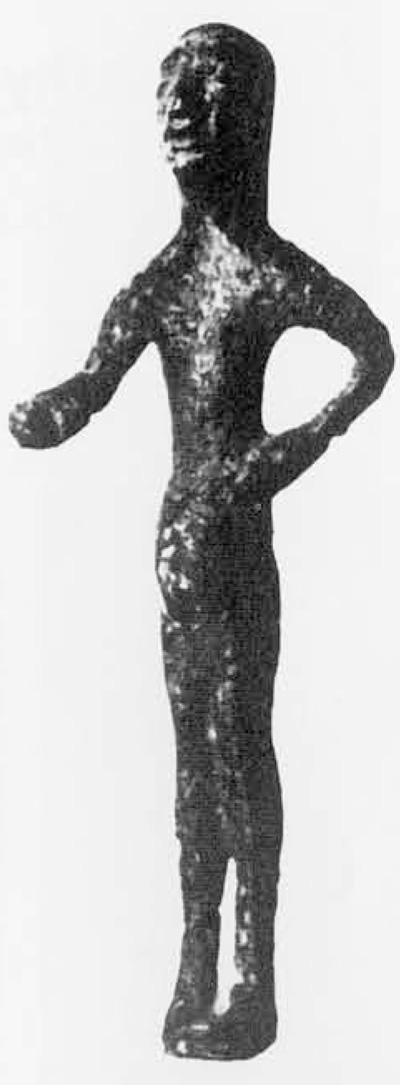
Italo-Etruscan ‘warrior’ statuettes have a distribution in France that curves from the Haute-Savoie to Brittany, while aquatic bird figurines are found clustered in the middle Loire region and in the Auvergne. With few exceptions, Italo-Etruscan figurines are generally absent from the Midi and the Rhone valley, implying a trans-Alpine route for their transmission.
Two round-based hemispherical cauldrons, each made from a single bronze sheet and with cruciform-handle attachments, are known from the Seine valley at Buchères (LeClert 1898: 248-9) and the Yonne valley at Cravant (Gaudron 1956). They belong to the latest series of cruciform-handled cauldrons, dated to the seventh century, whose production center was located at the head of the Adriatic, with a scattered diffusion along the upper Danube (Merhart 1952). An earlier biconical variant with a flat base, dated to the Late Bronze Age, was recovered in a bronze founder’s hoard in the Forest of Compiegne, near the Aisne-Oise confluence (Hémery 1937). Unlike its successors, the Compiegne cauldron probably originated in the manufacturing centers of central and eastern Europe.
Another seventh century import, most likely produced in Etruria, is the curious portable bronze ‘stove’ dredged from the Yonne at Sens (Hure 1931: 70-1). It is a hemispherical cauldron set on a perforated cylindrical base with three human heads, terminated by stylized aquatic birds with elongated necks, rivetted to the sides. Their serpent-like legs constitute the tripod on which the vessel stands.
Important changes in the number, type, context and distribution pattern of luxury imports occur in the later Hallstatt C, toward the beginning of the sixth century. The goods, although numerically greater, are more limited in range, being restricted almost exclusively to standardized types of bronze vessels which include ribbed pails, situlae, stamnoi and Schnabelkannen. In contrast to the preceding period, they are most often associated with rich tumulus burials, which occur in distinctive clusters.
This change is heralded by the arrival of ribbed pails (Fig. 6)—cylindrical vessels made from one or two bronze sheets, usually with nine cordons or ribs, and with mobile or fixed handles attached to double-loops rivetted to the rim. They are considered to be products of sixth century workshops operating in central Europe and the Balkans (Stjernquist 1967a; Bouloumié 1976). Four of the six examples from the Basin were found in burials. Three were used as cremation urns, one in a tumulus at Mardié in the middle Loire valley (Corot 1901: 549), and two in tumuli at Gurgy in the Yonne valley (Pellet and Delor 1980). One pail from Gurgy contained an unsually rich array of artifacts which comprised iron and silver-plated fibulae, gold earrings, bronze rings, a bronze leaf-shaped pendant, and beads of amber, glass and jet. A fourth pail was associated with an inhumation burial in a mound at Le Subdray in the Berry (Roger and Ponroy 1889-90). Two other pails from the Cher were stray finds.
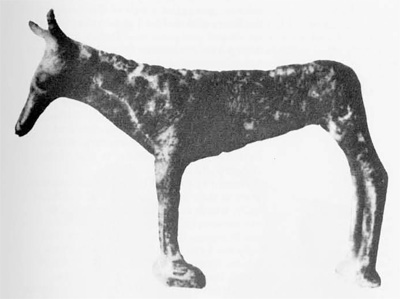
Ribbed pails from the Basin are mostly confined to the southern periphery, with an important group in the Berry around Bourges and examples along the middle Yonne and Loire valleys. A notable cluster of five pails is also known from mound burials in neighboring Upper Burgundy.
Bronze situlae, one of which was found with a ribbed pail in a grave in Tumulus V at Gurgy, occur in relatively greater numbers in the Paris Basin. Dated to the second half of the sixth and early fifth centuries, these flat-based truncated and globular vessels with high inverted shoulders, made from bronze sheets, were first produced in the Golasecca region of the Ticino (Kimmig 1962-3). They were also made in the Rhineland and exported westward and northward.
Situlae were employed as cremation urns in the southern half of the Basin, in the Berry and middle Yonne valley. One situla-urn was recovered from a grave in Bourges with a bronze Schnabelkanne and miscellaneous bronze ornaments (Breuil and Goy 1903). In the north, one situla comes from a presumed tumulus chariot-burial of the La Tène A in the Aisne valley at Pernant (Joffroy 1963). Although introduced at a slightly later date and present till the mid-fifth century, situlae have a distribution similar to that of the ribbed pails.
Bronze stamnoi (Fig. 7) are not common even in their production area of northern Italy, where only fifty are known from the cemeteries of Bologna, Spina and the Picenum. So it is not surprising that only ten have been discovered in trans-Alpine Europe (Bouloumié 1978: 7-8), of which three are from the Paris Basin.
Two have been found as cremation urns in a tumulus at Sainte-Genevève-des-Bois in the Loiret (Dauvois 1960), and one stamnos in the central burial in the tumulus at Courcelles-en-Montagne near the source of the Marne on the Langres Plateau (Déchelette 1913). The latter was associated with an Attic Kantharos which firmly dates the grave to the mid-fifth century, in the early La Tène A. The Loiret finds are thought to be a little earlier.
Bronze Schnabelkannen (Fig. 8a-c) are beaked wine-flagons with trefoil-shaped mouths; they frequently accompany stamnoi, having a similar distribution centered on northern Italy and the middle Rhine. They were manufactured in Etruria during the sixth and fifth centuries B.C. (Bouloumié 1973).
Although predominantly of La Tène A date in the Paris Basin, two Schnabelkannen can be placed in the later Hallstatt D. One is the previously mentioned find from Bourges, associated with a bronze situla, and the other is the fragment from a tumulus grave at Nijon, in the Haute-Marne, which was found with iron cart-fittings and pseudo-bucchero-nero pottery sherds (Lepage 1980).
Schnabelkannen, like situlae, are clustered in the Berry but also appear in the Champagne, where they are usually buried with iron chariot-fittings in barrow graves. The rarity of Schnabelkannen in southern France (apart from several Corsican finds) would indicate that they too were brought into France across the Alpine passes. Significant groups of Schnabelkannen are recorded in Upper Burgundy, the Franche-Comté and Alsace.
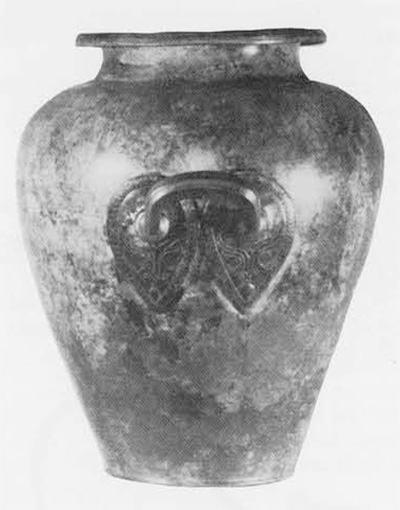
Further evidence of Etruscan fifth century bronze vessels in the Champagne is provided by the shallow basin from a probable chariot-burial at Bussy-le-Château (Bretz-Mahler 1971: 213). This resembles a find from the Pernant grave. Both belong to a well-defined series with a fairly wide distribution north and west of the Alps (Schaaf 1969).
A number of less standardized luxury products continued to be imparted into the Paris Basin in the sixth and early fifth centuries. Among sixth century imports, the bronze tripod from the Auxerrois (Rolley 1962) and the bronze griffon-head from Sens (Corot 1907: 109-10), both in the Yonne valley, can be mentioned. A second griffon-head is cited from Issoudun in the Berry (Anon. 1976: 316 fig. 8). It can be compared stylistically to several archaic Etruscan stone sculptures dated to the mid-sixth century (Hus 1961: 181).
Tripods and griffon-heads (Fig. 9) are customarily associated with Griefenkessel, bronze cauldrons with four to six griffon-heads rivetted to the sides, sometimes placed on a tripod, as is the example from the cart-burial in a tumulus at Saint-Colombe in the Côte-d’Or (Joffroy 1958: 60-2). While the type is ultimately of Greek origin, these particular pieces from the Basin are more likely to have been manufactured in Etruria.
Two bronze Etruscan figurines, assigned to the first half of the fifth century, were found at Bavay in the Nord and at Le Vieil Evreux in the Eure valley (Boucher 1976: 22-3). Their context is not specified. A third figurine was dredged from the Seine. Fifth century Etruscan figurines in France are also known from the Massif Central and the western Alpine region, but are notably absent from the Midi.
These various luxury bronze artifacts cannot be divorced from other, more numerous and more widely distributed, imports that include coral from the Mediterranean and amber, probably from the Baltic. These substances are present in a large percentage of late Hallstatt D and early Le Tène A burials across the Paris Basin, and are found most often as beads and as ornaments on fibulae.

The appearance of imported luxury products in the Basin requires explanation. With insufficient information on the nature of settlement generally in this area, only two sources are available from which any tentative conclusions can be drawn. One is the varying distribution pattern of luxury artifacts, the other, their respective achaeological contexts.
Explanation of Luxury Bronze Imports
A number of differences are apparent in a comparison of the distribution patterns and archaeological contexts of luxury goods of the seventh century on the one hand, and the sixth and early fifth centuries on the other.
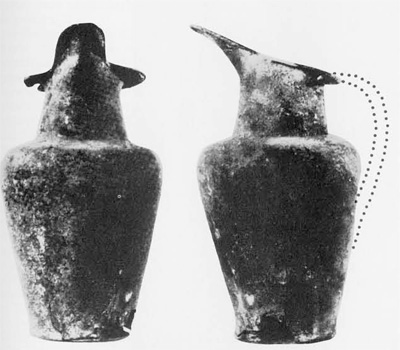
Seventh century finds have a predominantly riverine diffusion, sparsely distributed along the Seine and Loire and their tributaries, particularly the Yonne. Except for the rare hoard, usually indicative of Late Bronze Age material, these artifacts are either stray finds or river deposits. In contrast, sixth and early fifth century luxury products are found clustered not only in river valleys, especially the Yonne, but also on the chalk lands of the Berry and Champagne. The majority come from rich burials, mostly tumulus graves.
There is widespread agreement that the earliest Italo-Etruscan imports are linked to the tin trade (Villard 1960: 138-61). These seventh century bronzes represent attempts to secure routes leading to the principal sources of tin ore located at the Loire estuary, the Armorican peninsula and southern Cornwall, perhaps the famed Cassiterite Islands of classical geographies (Briard 1979: 192). An alternative route, from the Golfe du Lion down the Garonne to the Atlantic coast, does not seem to have been favored by Etruscan merchants.
The diffusion of seventh century luxury products along one of the major arteries of the tin trade suggests the existence of ‘transit’ zones placed at strategic points along the waterways, controlling the passage and general flow of commercial traffic. It reflects a system of inter-locking regional exchange networks where goods were traded internally (Rowlands 1973: 596-7) and where the production areas, in this instance Etruria, conducted indirect trade with their supply zones (Stjernquist 1967b: 30).
In this light, the Upper Burgundian region appears to have played a prominent intermediary role as witnessed by the importance attached to the Yonne and lower Seine, both natural outlet routes to the northwest. It is further evidenced by the Halstatt C cauldrons with cruciform-handle attachments from Buchères and Cravant, a comparable example being known also from the Côte-d’Or at Poiseul-la-Ville (Joffroy and Paris 1973).
Notable changes took place in the course of the sixth century that saw a tightening of relations between the two regions, culminating with the introduction into the Basin of ribbed pails from Upper Burgundy. The initial sign of change occurred with the spread of the tumulus inhumation rite along the southern periphery of the Basin in the later Hallstatt C, at a time when the northern regions retained their Late Bronze Age funeral rites and customs. This new rite is associated with the long iron sword, in several cases accompanied by bronze razors. The funerary rite and grave assemblages reflect current practices in Upper Burgundy. The Berry and Langres Plateau, both vital strategic regions with important deposits of workable surface iron ore, were particularly affected by these events.
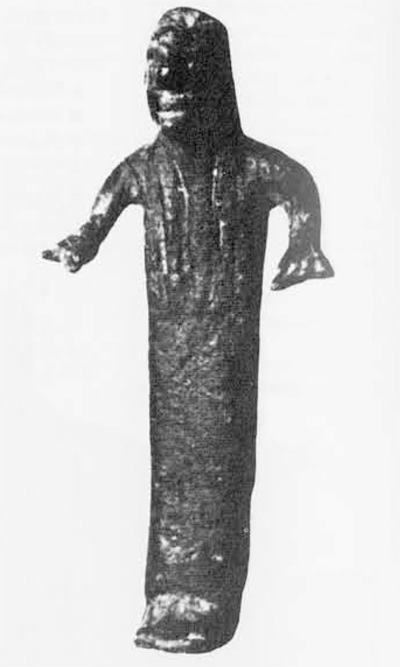
In order to establish more direct control over not only its supply routes but also the much needed mineral wealth, Upper Burgundy may have encouraged local leaders toward a higher degree of social and economic centralization. Tighter organization would entail not only more efficient exploitation of available resources but would also ensure more adequate protection and security of trade routes. With this in mind, the ribbed pails found clustered in the Berry and Yonne valley would have represented necessary incentives to and assurances of loyalty from regional rulers. It is no surprise that the arrival of ribbed pails in the Basin coincides with marked contrasts in grave wealth, reflecting an increase in social differentiation and the emergence of an élite. The appearance of situlae and Schnabelkannen in the Paris Basin, in the later sixth century, signals a shift to greater independence by regional ruling classes at a time when the Mediterranean world sought more direct links with its supply zones. The case is exemplified in the Berry where situlae and Schnabelkannen are well represented while being relatively rare in Upper Burgundy. The Berry’s growing isolation from its southeastern neighbor is further indicated by the absence of typical late Hallstatt D Burgundian artifacts, and by the reestablishment of contacts with the Poitou-Limousin region as shown by certain ceramic forms and motifs.
The distribution of the same late sixth and early fifth century luxury bronze imports highlights a new power center in northeastern Champagne. Their presence is directly related to the dramatic increase of tumulus chariot-burials in the early La rètie A. Although a seemingly abrupt phenomenon, this emerging warrior aristocracy in fact has its roots in the preceding late Hallstatt D regional ‘Jogassian’ phase. It is noteworthy that Upper Burgundian interests were gradually shifting in this earlier period from the Berry toward the Champagne by way of the Langres Plateau and the Marne. This is attested by the appearance of late Hallstatt D Burgundian artifacts, such as bronze ‘barrel’ bracelets, and objects known to have passed through Upper Burgundy from the Jura and Franche-Comte, like triangular and oval belt buckles in sheet bronze.
A recurring problem posed by Etruscan bronze vessels in the Champagne is the nature of the products exported in exchange for these imported luxuries. Numerous commodities have been proposed, especially such items as cereals, cattle and slaves, which would not be represented in the archaeological record as recognizable trade items.
In reviewing the influential role exercised by the Upper Burgundian region, it is necessary to underline the vital part played by the fortified hill-settlement of Mont-Lassois in the Côte-d’Or. This site and the adjacent spectacularly rich late Hallstatt D princely burial at Vix qualify as one of the most important complexes in the western Hallstatt zone (Joffroy 1960). Its primacy was largely due to its strategic position at the head of the Seine, adjacent to the Rhône-Saône ‘corridor,’ particularly after the founding of the Phoceaen colony at Massalia (Marseille) near the Rhône estuary in ca. 600 B.C.
The extent of Massalia’s participation in conveying luxury goods destined for the Paris Basin, via Mont-Lassois, is difficult to assess, and subject to contrasting opinions. It seems likely, in my opinion, that the majority of luxury bronze imports from the Basin were carried across the Alpine passes, and comprised items from central and southeastern Europe as well as Italo-Etruscan goods.
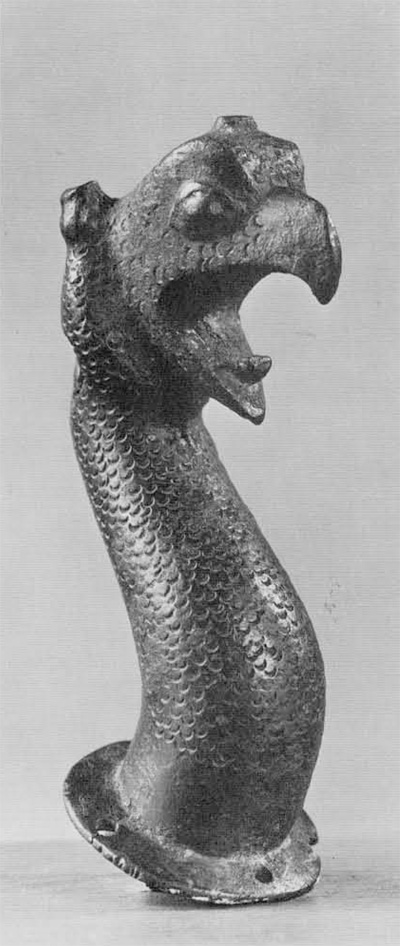
However, Massalia was indeed instrumental in exporting Greek materials up the Rhône-Saône ‘corridor’ to the ‘Celtic’ hinterlands. Although predominantly ceramic, these exports did include a number of bronze artifacts, notably certain types of sixth century ‘boss-and-barb’ and trilobate arrowheads, examples of which are diffused along Strabo’s land route to the Cornish tin sources, tracing a curve from the Rhône estuary to the mouth of the Seine. Interestingly, though, these arrowheads have not been found on Mont-Lassois where they would be most expected.
Despite the fact that Greek pottery does not arrive in the Paris Basin until the early La Tène A in the fifth century (the earliest find being the Attic Red Figure Kantharos from the Courcelles-en-Montagne burial), Massalia’s most important material contribution in the sixth century was in the ceramic field. The importation of large quantities of new wares following the establishment of Massalia incited local native copies in southern France. Some of the latter reached the Paris Basin, for example the imitation bucchero-nero vessel from the cart-burial at Nijon, associated with a Schnabelkanne fragment. Another indirect consequence was the widespread adoption of barbotine-painted motifs, inspired by imported polychrome wares. Mont-Lassois was a pivotal intermediary in introducing this technique, as well as several distinctive pottery forms, into the Paris Basin in the Hallstatt D.
Conclusion
Although the word ‘luxury’ denotes a quality of superfluity, the products under discussion were a vital factor ensuring the circulation of materials between very different societies. Several studies, in large measure based on anthropological models, have demonstrated the crucial role played by these luxury bronze artifacts both to Mediterranean economic interests and to internal social structures in trans-Alpine Europe (Frankenstein and Rowlands 1978; Wells 1980).
The lack of adequate settlement evidence from the Paris Basin severely limits any debate on the subject of internal social and economic structural changes brought about by luxury artifacts. What these imports do reveal, however, is the increasing interest shown by the Mediterranean world in the economic potential of the Basin. Contact was at first indirect, relying on a system of inter-regional exchange networks. By the end of the sixth century, more direct trade links were established.
Pressures for social change, apparent in the movement toward centralization that increasingly characterizes development in the Paris Basin from the Hallstatt C onwards, came from various directions. In addition to those induced by contact with external cultures, an important factor was the need to exploit local resources more effectively for a growing population and an expanding export market. Strong centralized organizations were called for to maintain social and economic stability by controlling access to and production of available resources, and by creating redistribution networks. A consequence of this process was the increase in social differentiation, reflected in the growing disparity in grave wealth.
The luxury bronze imports were initially destined for a very limited class of rulers in the later sixth century. When their quantity was increased in the beginning of the fifth century, the range of available luxury products became more limited and standardized.
There is a general consensus that the majority of the luxury bronze vessels were used for mixing and serving wine, a plentiful and steady supply of which was assured upon the foundation of Massalia. The social and political importance of the feast, known from later Celtic written sources, is legendary. It can be surmised that the status of a local leader would be greatly enhanced if he were to produce wine in an imported bronze vessel on such an occasion.
